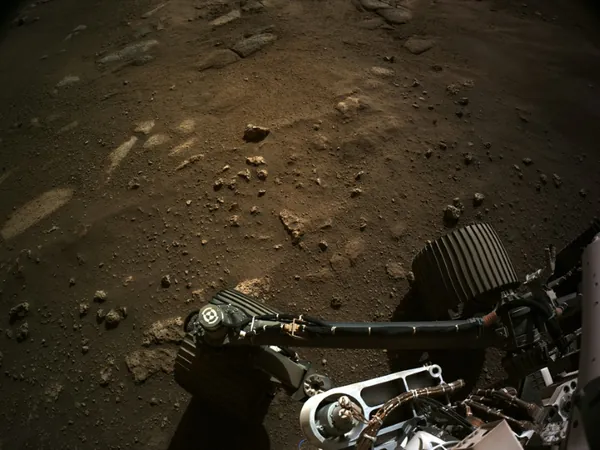
Mars Awaits: The Daring Gamble of Sending Humans to the Red Planet
2025-06-06
Author: Daniel
A crewed mission to Mars: a breathtaking endeavor that could redefine human exploration. It's not just a dream anymore; U.S. President Donald Trump has committed to making it a national priority, igniting renewed passion for this cosmic quest.
Why Venture to Mars?
NASA's visionary "Moon to Mars" strategy emphasizes humanity's deep-rooted desire to explore the cosmos. A mission to Mars promises to uncover the planet's mysteries—could it have once harbored life? What clues does its geology hold about our solar system? Furthermore, the endeavor has geopolitical complexities, as Trump has passionately declared the ambition to "plant the American flag on Mars," speaking to a grand vision of American progress.
Yet, challenges lurk in the shadows. Critics spotlight cuts to NASA's budget and the halt of vital missions, including those that would return samples from the Perseverance rover. According to the esteemed astrophysicist John Mather, exploration transcends mere travel—it's about fundamentally enhancing our understanding of the universe.
The Journey to the Red Planet
Elon Musk is banking on SpaceX's revolutionary Starship, the most massive rocket constructed, despite its troubled testing history with nine fiery failures. Musk aims for an uncrewed launch by late 2026, coinciding with the next advantageous Earth-Mars orbital alignment.
However, experts maintain that this timeline may be overly ambitious. Starship still needs to demonstrate crucial capabilities like in-orbit refueling and successful landings.
While some technical insights remain undisclosed, NASA’s nuclear propulsion chief Kurt Polzin champions Nuclear Thermal Propulsion (NTP)—a technology that could mitigate the need for refueling in space and provide powerful thrust.
Surviving the Cosmos
Astronauts might face a daunting seven-to-nine-month journey in a confined spacecraft, braving intense radiation beyond Earth’s protective magnetosphere. Solutions for shielding range from using heavy materials to active methods like plasma fields. Additionally, drug advancements are in progress to help minimize cellular damage.
On Mars, crews will need to combat the effects of low gravity—potential muscle and bone deterioration—with rigorous exercise. Mental health remains a pressing issue, too; experiments on the International Space Station (ISS) show that growing plants improves morale.
Communicating with Earth poses another complication, as the time delay prevents real-time data sharing crucial for preventing hazards during the journey.
Unraveling the Martian Enigma
Upon reaching Mars, uncertainty swells. Previous missions have uncovered tantalizing hints, such as organic molecules and seasonal methane, yet definitive proof of life still eludes us. Earth’s resilient extremophiles provide hope, hinting that life might persist even in harsh Martian conditions.
While plans for nuclear power on Mars surface operations have been set, other critical decisions—like crop selection and habitat design—remain unresolved. Space architect Phnam Bagley emphasizes the significance of accommodating Mars' unique day duration, which could disrupt sleep and increase stress among astronauts.
The Future of Human Life on Mars
The inaugural Mars mission is projected to last about 500 days on the surface, but the concept of long-term colonization stirs profound questions. Notably, scientists still grapple with whether human embryos can develop under low-gravity conditions, raising concerns about childbirth on the Red Planet.
NASA's Erik Antonsen stresses the importance of acknowledging these possibilities, stating, "Even if you don't plan on it, people will still engage in intimacy, presenting real medical dilemmas." The intricate web of challenges surrounding human life on Mars highlights the audacity and complexity of this great interplanetary endeavor.




 Brasil (PT)
Brasil (PT)
 Canada (EN)
Canada (EN)
 Chile (ES)
Chile (ES)
 Česko (CS)
Česko (CS)
 대한민국 (KO)
대한민국 (KO)
 España (ES)
España (ES)
 France (FR)
France (FR)
 Hong Kong (EN)
Hong Kong (EN)
 Italia (IT)
Italia (IT)
 日本 (JA)
日本 (JA)
 Magyarország (HU)
Magyarország (HU)
 Norge (NO)
Norge (NO)
 Polska (PL)
Polska (PL)
 Schweiz (DE)
Schweiz (DE)
 Singapore (EN)
Singapore (EN)
 Sverige (SV)
Sverige (SV)
 Suomi (FI)
Suomi (FI)
 Türkiye (TR)
Türkiye (TR)
 الإمارات العربية المتحدة (AR)
الإمارات العربية المتحدة (AR)